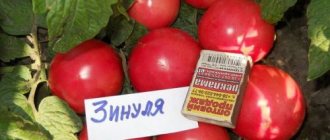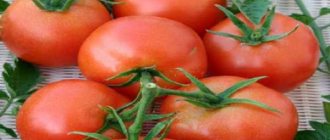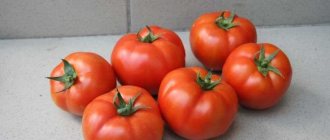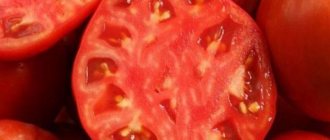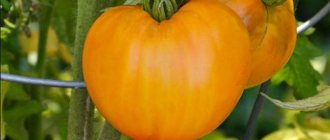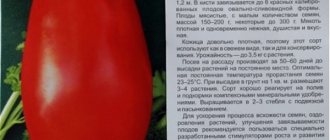Tomato Slastena is a small-fruited variety from the cherry category. It produces masses of small, red, round fruits that can be eaten fresh as a snack, used to garnish dishes, and preserved in glass jars.
| Height | Landing location | Ripening time | Fruit color | Fruit size | Origin | Fruit shape |
| Medium height | Greenhouse, Open ground | Early ripening | Reds | Small | Variety | Round |
general information
Description of the variety - indeterminate bushes, standard, up to 1 - 1.1 m in height in a summer cottage, up to 1.3 m in greenhouses. The foliage is sparse, the leaves are medium-sized, dark green. The first brush appears above the 8th - 9th sheet, the subsequent ones - every 3 sheets. There are 30 - 40 tomatoes on one brush.
Characteristics of the fruit: slightly elongated, cylindrical in shape. Ripe tomatoes are scarlet and burgundy. They have thick skin. Sweet, with a honey aftertaste. Fruit weight - 30 - 50 g, on the first clusters - up to 70 g. There are 4 seed chambers, the presence of dry matter is 6%. They are eaten fresh, put in salads, canned, juiced, made into ketchup and lecho. Not suitable for barrel pickling.
"Sweet Bunch"
The originator of the variety is Agrofirma Sedek LLC, Moscow region. The tomato entered the register in 2009 and has already gained popularity.
The variety is recommended for all regions of the country for greenhouses, greenhouses and private gardens as an early ripening salad product. The surplus is perfect for canning, either on its own or as an assortment with other vegetables.
The plant form is tall, indeterminate, the leaves are very large.
The fruit is round, dense with a smooth red skin.
Tomatoes with an average weight of about 30 g and two seed cavities filled with juice and small seeds.
Advantages and disadvantages
Tomatoes have a number of advantages:
- small sweetish tomatoes;
- the skin does not burst;
- tie together;
- the variety is resistant to sudden temperature changes;
- tomatoes ripen quickly;
- easy to transport;
- the yield is high: up to 2 - 2.5 kg of fruits are harvested from a bush, up to 8 kg from 1 m², and up to 10 kg in a greenhouse;
- bushes can grow even on depleted lands;
- are stored for a long time;
- the variety is moderately resistant to brown spot, root rot, and late blight;
- good for canning.
Among the small disadvantages are that the bushes need to be tied up, the stepsons need to be torn off, and the branches need to be propped up.
"Sweet Baby"
An early-ripening varietal novelty was presented by Euro-Seeds LLC, Moscow in 2015. The variety successfully passed the test and was recognized for cultivation in all regions of the country in vegetable gardens and vegetable gardens.
The plant is tall and requires attention and tying up.
The fruits are red, small, and weigh no more than 8 g. They taste very sweet, with a pleasant aftertaste. Round shape, tender skin, two seed nests.
The yield of the variety is within 3.5 kg/m2 of garden area.
Sowing seeds
Tomato seeds of the Slastena Nastya F1 variety are sown at the end of March. If you purchased seeds at the market, they are disinfected. The seeds are poured into a gauze bag and left for 20 minutes. into a solution of potassium permanganate (pour 1 g into half a glass of clean water). It is not recommended to keep seeds in potassium permanganate for longer than 20 minutes, as their germination rate decreases. Then rinse the seeds with clean water.
Instead of potassium permanganate, you can make a soda solution. Pour 0.5 g of soda into half a glass of water. Place the seeds in a soda solution for 24 hours.
Make soil from equal parts of peat soil, turf soil, and humus. Add 1 teaspoon of superphosphate, urea, and potassium sulfate to one bucket of prepared soil. Disinfect the soil by spilling it with a strong solution of potassium permanganate. Then let the soil remain moist for 10 days to allow beneficial bacteria to multiply.
See also
Characteristics and description of the tomato variety Yellow Cherry (golden)Read
Place the seeds in the soil. Sprinkle with soil so that the seeds are buried 1 cm. Water with a spray bottle. Cover with film and place in a warm place. The air temperature should be 25 - 30 degrees.
Natalya Dryzhakova, collector from Yaroslavl
The collection includes more than 350 varieties.
It's no secret that tomatoes of the same variety in different years of cultivation may differ in taste. And this is due to a number of factors, primarily the growing technology used, nutrition level, soil type, and degree of solar exposure. And yet, to a greater extent, the taste of tomatoes directly depends on the variety they belong to!
I have been growing the varieties that I want to talk about for a very long time.
For several decades now, my legendary old Soviet variety, Bull's Heart, has remained the unsurpassed leader. Popular during the Soviet era and loved by all gardeners, this variety remains a favorite to this day.
This tomato has been in my collection since 1983, and no matter what years I grew it, the variety invariably pleases with its productivity and the unique sweet taste of large, heart-shaped fruits.
Plants of this variety are tall, densely leafy, with large fruits weighing 400-600 g. Tomatoes with dense juicy pulp, rich sweet taste. Good both in salads and for making aromatic juices.
It is preferable to grow in closed ground with the formation of plants with 1-2 stems. It is necessary to tie each fruit cluster to avoid breaking them.
The Monomakh Cap variety is also from a series of classic Soviet varieties - reliable, time-tested and in any weather conditions.
The variety is tall, very productive, with large crimson-colored fruits. The pulp of the fruit is thick, dense texture, rich sweet taste. The fruits are always large - up to 500-600 g, in other years they can reach up to 800-900 g.
In our area (Yaroslavl region), I always grow it in closed ground (nearby greenhouse) with the formation of plants of 1-2 stems. The variety is very responsive to good care, balanced nutrition and fertilizing throughout the growing season.
All the brightness of taste and rich sweetness can only be felt in fruits that are fully ripened on the plant itself, and not in fruits ripened at home on the windowsill.
Among the orange-fruited varieties, one of the leaders in sweetness is the Hawaiian Pineapple. This is a long-time favorite of my collection, I appreciate it for the unusual peach color of the fruit, for its delicate, sweet, aromatic pulp with a predominance of fruity notes.
The variety is tall, I always grow it in closed ground with the formation of plants into 2 stems. Forms clusters with 4-5 large fruits, weighing up to 300-400 g. The pulp inside is two-colored, juicy, with the most delicate sweet taste. I pick the fruits from the plant only when they are fully ripe, then you can fully enjoy the unique taste of these exotic tomatoes.
And how unusually beautiful these plants look in the greenhouse, when at the end of the season, fully loaded brushes with large fruits of a delicate peach color hang on each of them!
I can’t help but name another orange-fruited variety from this series – the Nizami variety. This is an old heirloom variety from Georgia, given to me at the autumn exhibition in 2013.
The variety is tall, mid-season, with an elegant bush structure. The stems of the plants are thin, but strong enough to support large, heart-shaped fruits weighing up to 250-350 g each. The pulp of the fruit is from the “buttery” series, dense, cuts like butter, sweet, with a bright, rich taste.
The variety works better when grown indoors (in our climate zone) and when plants are formed into 2-3 stems. It will thank you for good care, proper agricultural technology and balanced nutrition throughout the growing season with large, sweet, bright orange fruits.
The variety is included in the TOP 10 best sweet varieties every year and has received a permanent residence in my collection.
Growing seedlings
When shoots appear, remove the film. Place the box on the windowsill. Seedlings are picked when 2 true leaves appear and transplanted into peat cups. To grow seedlings in the absence of sun, illuminate them with lamps.
Water the seedlings with a spray bottle in the morning. 2 weeks before transplanting, begin to harden the bushes by taking them out onto the balcony. First, place them on the loggia for 5 minutes, then increase the interval the seedlings are in the open air.
Transplanting
In the fall, spread 4 kg of manure onto 1 m² of land and dig the soil to the depth of a shovel. In the spring, scatter the same amount of manure over the soil, but the manure must be rotted. Also sprinkle 1 tbsp per 1 m² of soil. a spoonful of potassium chloride and 5 tbsp. spoons of superphosphate. Dig the soil a second time. Although, in general, this variety is not picky about the composition of the soil.
Dig holes with a diameter of 15 cm and a depth of 30 cm. Drive in pegs. Place the seedlings into the holes. 4 bushes are placed per 1 m², doing this in a checkerboard pattern. Water the plantings thoroughly. Tie up the bushes.
Care
Feed the tomatoes for the first time 10 days after planting on the site. Pour 1 kg of manure into a ten-liter bucket of water. Let it sit for a while. Then water, being careful not to get it on the leaves. Fertilize at the same time as watering. After each watering or rain, loosen the soil. After the first fertilizing, mulch the ground with straw and pine needles in a 5 cm layer.
In addition to tying the trunk, you also need to tie the hands. If you planted seedlings in a greenhouse, then form a bush with 2 stems, if in open ground - with 3 stems. Every 10 days, cut off the stepsons.
Best reviews from our readers
- Alla
In 2021, she grew three Nastya-Slastena bushes in a greenhouse. Of the three different cherry varieties (which were both smaller and more sour), I liked this one the most. Height up to 2 meters, 2-3 stems, clusters are really prolific—20-25 pieces. What I especially liked is that the fruits are sweet, 3 cm in diameter (which is larger than other “cherries”) and there are a lot of them! Fruited until October. Good keeping quality and ripening at home. I will buy this variety again and plant more, because... Both children and adults really liked this cherry variety. - Vera Miroshnichenko
I planted it in a greenhouse, but grafted it, i.e. two roots and two stems. The harvest, if I may say so, was mind-blowing, however, the food came from two roots. I did this for the first time, I really liked it. There are still tomatoes, but it’s already the end of October and this is in our zone. The variety is wonderful in taste too!
- Irina
I really like it. When properly formed, they grow very tall with beautiful clusters of sweet cherry blossoms. Beautiful and sweet. Can be formed into 2-3 trunks.
Diseases and pests
Be sure to take preventative measures. Ventilate the greenhouse daily. The variety tolerates sudden temperature changes well, but it is better to monitor the temperature in the greenhouse.
See also
Description of the tomato variety Magic Harp and its characteristicsRead
Slugs love tomatoes. Pull weeds promptly. Sprinkle lime on the ground, but make sure the soil does not become alkaline. You can add coarse sand, ground egg shells or nuts. Very often bushes are attacked by aphids. To eliminate pests, spray the plantings with Zubr. If whitefly appears on the bushes, spray with Confidor.
Reviews about the variety are extremely positive: children love small, sweet Cherry tomatoes.
"Zelenushka F1"
The name of this hybrid, most likely, was not very attractive to the packer and it was renamed the “Green Sweet Tomato” tomato.
The hybrid was entered into the register in 2007, and its originator is Selection and Seed Agro Moscow Region LLC. Mytishchi.
The hybrid is recommended for cultivation in the Northern, Central, Northwestern, Volga-Vyatka, Central Black Earth, North Caucasus and Middle Volga regions.
The tomato is intended for greenhouses and light film shelters for vegetable growers' private farms.
Once planted in a greenhouse, already on day 115 you will be able to taste the harvest. The plant is determinate, and the leaf blade is recognizable; it is unusually wide, short-truncated and light green in color.
The fruit is round, dense, one might even say hard, with a smooth, pleasant skin. During the period of growth and technical maturity, it is green with a bright, rich, dark green spot at the stalk. Ripening, dark greens dissolve, and the tomato acquires light amber shades. At the stage of biological maturity, the fruits are emerald-amber in color.
The fruit has 2 seed nests, and the average weight does not exceed 12 g.
Tomatoes have excellent taste. Having an interesting color, they resemble large gooseberries, which attracts children to the bushes.
The hybrid is very disease resistant. Tobacco mosaic virus, cladosporiosis, and fusarium never affect the hybrid.
- excellent taste;
- interesting color;
- excellent keeping quality;
- good product yield;
- high transportability.
Other tomato varieties with similar names
In addition to the Slastena variety, the State Register includes 3 more varieties with similar names.
The Lakomka variety was included in the State Register in 2003. The bushes are determinate, that is, they stop growing when flowers appear, up to 55–60 cm in height. The variety is early ripening. The bushes are semi-spreading. Tomatoes are round in shape, weighing 100 - 120 g. Ripe tomatoes are raspberry-colored, they have a wonderful dessert taste. Collect 6 – 7 kg per 1 m². The variety is drought resistant. Is immune to blossom end rot.
The Sladkoezhka variety was included in the State Register in 2009. An early ripening variety. The bushes are indeterminate; they need to be formed into one stem and tied up. Refers to Cherry tomatoes, fruit weight 35 - 40 g. The tomatoes are round, of excellent taste. Plant 4 bushes per 1 m².
The Anastasia variety was included in the State Register in 2007. The bushes are determinate, but they still need to be formed and tied up. The fruits are elliptical in shape and red in color. Tomato weight is 100 - 120 g. They have a good taste. 8 kg of fruits are collected from 1 m².
"Sweet Million"
Considering the sweet tomato series, reviews, photo yield, one cannot help but consider the tomato, which has long been heard by vegetable growers due to its merits.
Thanks to Agrofirma Aelita LLC, Moscow, in 2001 the variety was entered into the register and recommended for all regions of the Russian Federation. Both farmers and vegetable growers can grow the variety in their garden plots under film covers.
The plant, although indeterminate, is of medium height and rarely grows above 150 cm. The first inflorescence is formed above the 8th leaf, and then after 1-2.
The fruit formation is round and smooth, red-scarlet in color with 2-3 nests.
The taste of the tomatoes is excellent, balanced, aromatic with a slight piquancy, which makes the tomato recognizable.
The plant is very resistant to the main contagious diseases of tomatoes.
- early ripening of the crop;
- excellent taste;
- compactness of the vegetative form and brush;
- maturation is friendly and generous;
- disease resistance.
